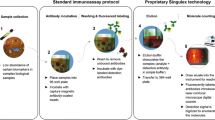Abstract
Immunoassays are analytical methods using antibody-specific reactions to analyze samples. Due to recent developments in antibody technology, the scope of potential samples has expanded to not only proteins, but also low molecular-weight compounds, carbohydrates, lipids, and microorganisms. Immunoassays have the advantage of being highly sensitive, capable of detecting small amounts, and thus have potential for application in biosensors. Immunoassays using magnetic beads have been developed and can be converted to more diverse platforms than the existing limited well plate-based assay. Furthermore, magnetic bead immunoassays detect analytical samples more quickly, and are becoming one of the most suitable immunoassay tools applicable to biosensors. However, their development requires optimization for the improvement of detection ability for specific samples. Therefore, we propose a guideline for solving detection problems occurring in magnetic bead immunoassay optimization processes. It is aimed to be a good reference, enabling researchers performing such optimization more quickly and efficiently
Similar content being viewed by others
References
I. A. Darwish, Int. J. Biomed. Sci., 2, 217 (2006).
G. A. Bonwick and C. J. Smith, Int. J. Food Sci. Technol., 39, 817 (2004).
R.M. Lequin, Clin. Chem., 51, 2415 (2005).
A. H. Wu, Clin. Chim. Acta, 369, 119 (2006).
K.-Y. Lien, L.-Y. Hung, T.-B. Huang, Y.-C. Tsai, H.-Y. Lei and G.-B. Lee, Biosens. Bioelectron., 26, 3900 (2011).
Ø.W. Rønning and A. C. Christophersen, Hybridoma, 10, 641 (1991).
T. Aytur, J. Foley, M. Anwar, B. Boser, E. Harris and P.R. Beatty, J. Immunol. Methods, 314, 21 (2006).
T. Jackson and R. Ekins, J. Immunol. Methods, 87, 13 (1986).
P. Nikitin, P. Vetoshko and T. Ksenevich, Sens. Lett., 5, 296 (2007).
S. Gundersen, I. Haagensen, T. Jonassen, K. Figenschau, N. De Jonge and A. Deelder, J. Immunol. Methods, 148, 1 (1992).
F. Zhao, Q. Shen, H. Wang, X. Han and Z. Yang, Food Control, 79, 227 (2017).
A. Radoi, M. Targa, B. Prieto-Simon and J.-L. Marty, Talanta, 77, 138 (2008).
S. Yu, F. Yu, Y. Li, L. Liu, H. Zhang, L. Qu and Y. Wu, Food Control, 60, 500 (2016).
D.-H. Jung, K. Min, Y. Jeon, W. Jang and Y. Kwon, Biochip J., 6, 293 (2012).
J. Andreassen, Immunodiagnostic, 29, 22 (2005).
R. Perraut, M. Varela, B. Mbengue, M. Guillotte, O. Mercereau-Puijalon and I. Vigan-womas, J. Immunol. Tech. Infect. Dis., 4, 1 (2015).
Author information
Authors and Affiliations
Corresponding authors
Rights and permissions
About this article
Cite this article
Son, J., Hwang, J., Lee, D. et al. Strategies for the optimization of bead-immunoassays for the effective detection of target biomolecules. Korean J. Chem. Eng. 35, 805–811 (2018). https://doi.org/10.1007/s11814-017-0323-7
Received:
Accepted:
Published:
Issue Date:
DOI: https://doi.org/10.1007/s11814-017-0323-7




